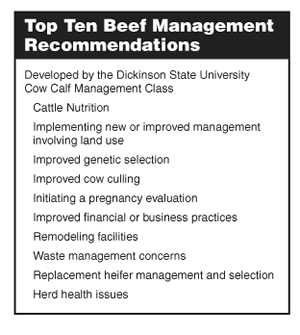
Kris Ringwall
Beef Talk
Top 10 beef management recommendations.
As we age, we gain wisdom through life experiences. Although these experiences may be very difficult at times, we generally emerge with more insight and understanding as we follow the many trails we take in life. In contrast, our earlier years are filled with more raw desire and a willingness to bulldoze something if necessary to accomplish the tasks at hand.
I teach a cow-calf production class with Chip Poland, former North Dakota State University (NDSU) area Extension livestock specialist, at Dickinson State University. We team the students with North Dakota Beef Cattle Improvement Association (NDBCIA) producers to develop a mentoring relationship.
In the process, we create a bridge matching the less-experienced student with producers who have more experience. Each student has to identify 15 management practices that could be discussed with a producer and then narrow the list to three management practices that have a reasonable chance of being implemented.
 In general, the students identified management practices for 24 different beef operations. The next step was to identify the top 10 management practices by categorizing the student suggestions into logical groups.
In general, the students identified management practices for 24 different beef operations. The next step was to identify the top 10 management practices by categorizing the student suggestions into logical groups.
The different management areas differ slightly. The exact categories are not as important as the general principle that there still is something to think about whenever someone looks at an operation and then offers suggestions for improvement.
The suggestions offered by the students will be tempered by the experiences of the producers. The thought that something could be improved is good to hear, even for the most seasoned producer.
The top suggestions
Perhaps, without too much surprise, nutrition topped the list with 15 different suggestions identified. Utilizing feedstuff analysis, along with a better inventory of feed and ration formulations, was noted more than once.
The second leading response was a tie. Implementing new or improved management that involved land use and improved genetic selection were identified for 13 operations.
Better planning and grazing system development was suggested, as well as the exploration and use of cover crops or other agronomic practices that would improve or extend grazing or forage production capabilities.
In regard to genetic selection, recommendations primarily involved a more focused bull selection, particularly when it comes to birth weight.
The fourth category was cow culling. The issues that led this discussion were cow disposition, reproductive failure and age.
The next areas included initiating a pregnancy evaluation process, improving financial or business practices, remodeling facilities and waste management concerns. Tied for ninth place were replacement heifer management and selection and herd health issues.
The undertone of the discussion also was interesting. Producers had a more guarded approach for personal safety when working and have the lingering question of who is going to take over the operation when he or she retires.
There was much discussion on the generational transfer of agricultural property. No quick solutions were found. However, the need to communicate was very evident.
The challenge of changing management practices needs to be supported by data. In order to justify the proposed changes, the monitoring process involves a need to recheck the data that was used to suggest the management change in the first place.
The recommendations need to be sorted for the bulldozer effect, which is that youthful desire just to do something because one wants to. Existing producers always need to make sure change brings dollars or else things won't work out as expected.
Remember to work the process on paper first. Only proceed when the numbers show a positive response. For current producers, change is never easy, and making way for the next generation is even harder.
One could reflect on all the discussion there was about vaccinating calves during the last two decades. However, it is interesting that vaccinating calves barely made the top 10 list. The reason is that the industry changed. Vaccinating calves now is a standard operating procedure, at least for the herds visited by the students.
So, one thing is for sure. There will be a next generation. Hopefully, the next generation will not only follow in our footsteps but will be wiser and keener as it approaches the future.
Your comments are always welcome at http://www.beeftalk.com.
Comment on this article.




